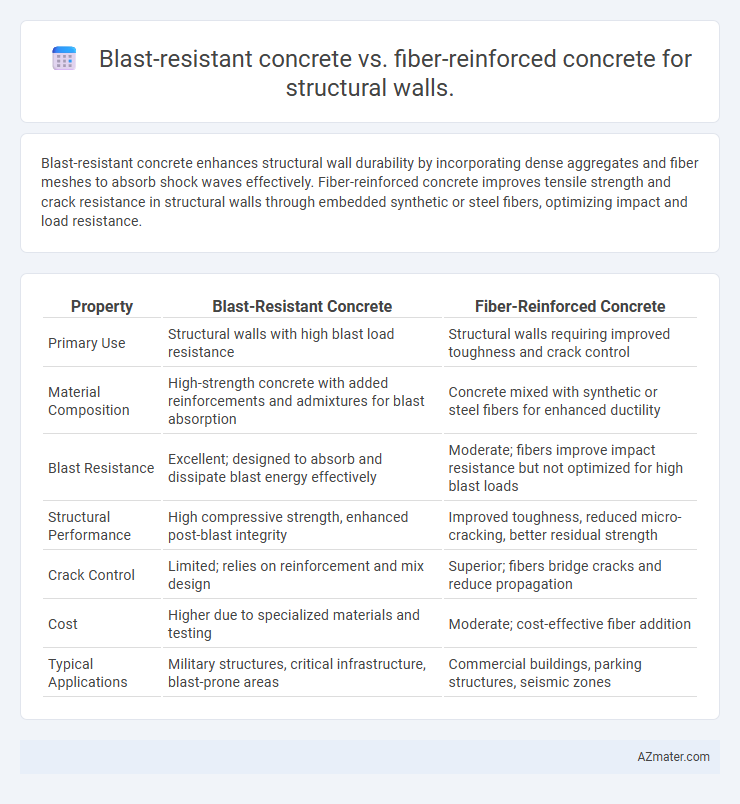Blast-resistant concrete enhances structural wall durability by incorporating dense aggregates and fiber meshes to absorb shock waves effectively. Fiber-reinforced concrete improves tensile strength and crack resistance in structural walls through embedded synthetic or steel fibers, optimizing impact and load resistance.
Table of Comparison
| Property | Blast-Resistant Concrete | Fiber-Reinforced Concrete |
|---|---|---|
| Primary Use | Structural walls with high blast load resistance | Structural walls requiring improved toughness and crack control |
| Material Composition | High-strength concrete with added reinforcements and admixtures for blast absorption | Concrete mixed with synthetic or steel fibers for enhanced ductility |
| Blast Resistance | Excellent; designed to absorb and dissipate blast energy effectively | Moderate; fibers improve impact resistance but not optimized for high blast loads |
| Structural Performance | High compressive strength, enhanced post-blast integrity | Improved toughness, reduced micro-cracking, better residual strength |
| Crack Control | Limited; relies on reinforcement and mix design | Superior; fibers bridge cracks and reduce propagation |
| Cost | Higher due to specialized materials and testing | Moderate; cost-effective fiber addition |
| Typical Applications | Military structures, critical infrastructure, blast-prone areas | Commercial buildings, parking structures, seismic zones |
Introduction to Blast-Resistant and Fiber-Reinforced Concrete
Blast-resistant concrete is engineered to withstand high-pressure shock waves from explosions, enhancing structural wall safety in hazardous environments. Fiber-reinforced concrete incorporates synthetic or steel fibers that improve tensile strength and crack resistance, offering superior durability under blast loads. Both materials are critical in designing resilient structural walls that mitigate blast impact while maintaining integrity.
Fundamental Material Properties Comparison
Blast-resistant concrete exhibits high compressive strength and enhanced energy absorption capacity due to its dense microstructure and specialized admixtures, making it ideal for withstanding high-intensity dynamic loads. Fiber-reinforced concrete incorporates synthetic or steel fibers that significantly improve tensile strength, crack resistance, and ductility, enhancing the structural wall's post-impact performance. Comparing fundamental properties, blast-resistant concrete prioritizes stiffness and compressive robustness, while fiber-reinforced concrete emphasizes toughness and deformability under blast-induced stress.
Structural Performance Under Extreme Loads
Blast-resistant concrete offers superior energy absorption and high compressive strength, effectively mitigating explosive impacts on structural walls. Fiber-reinforced concrete enhances tensile strength and crack resistance, improving ductility and post-blast integrity. Combining these materials can optimize structural performance under extreme load conditions, balancing strength and flexibility to reduce catastrophic failures.
Energy Absorption and Impact Resistance
Blast-resistant concrete exhibits superior energy absorption and impact resistance due to its dense matrix and embedded energy-dissipating materials such as polymers and steel fibers. Fiber-reinforced concrete enhances impact resistance by integrating synthetic or steel fibers, which improve tensile strength and crack control but may provide less energy absorption compared to specialized blast-resistant mixes. For structural walls requiring maximum protection against explosive forces, blast-resistant concrete offers optimized energy dissipation and structural integrity over standard fiber-reinforced formulations.
Crack Control and Durability Enhancements
Blast-resistant concrete incorporates specialized aggregates and admixtures to enhance energy absorption and minimize spalling under high-pressure impacts, significantly improving crack control and structural durability. Fiber-reinforced concrete integrates steel, glass, or synthetic fibers that distribute tensile stresses uniformly, reducing crack propagation and enhancing toughness and longevity in structural walls. Optimizing fiber content alongside blast-resistant mix designs yields superior durability by combining impact resistance with controlled crack development in critical structural applications.
Reinforcement Materials and Their Effects
Blast-resistant concrete incorporates specialized aggregates and admixtures to enhance energy absorption and fracture toughness, significantly improving impact resistance in structural walls. Fiber-reinforced concrete employs synthetic or steel fibers that distribute stress and control crack propagation, increasing tensile strength and ductility. The choice of reinforcement materials directly influences the wall's ability to withstand dynamic loads, with blast-resistant mixes excelling in shock wave dissipation and fiber-reinforced mixes enhancing post-crack load-bearing capacity.
Construction Methods and Practical Considerations
Blast-resistant concrete requires specialized mix designs with high-strength aggregates and dense reinforcement to withstand explosive forces, often necessitating slower curing times and advanced casting techniques to ensure structural integrity. Fiber-reinforced concrete utilizes discrete fibers such as steel, glass, or synthetic materials dispersed throughout the mix, improving crack resistance and toughness without significantly altering standard pouring and finishing methods. Practical considerations include cost implications, construction timelines, and the need for skilled labor familiar with handling fiber integration versus the stringent quality controls needed for blast-resistant formulations.
Cost Analysis and Maintenance Requirements
Blast-resistant concrete typically incurs higher initial costs due to specialized materials and design specifications aimed at absorbing and dissipating explosive forces, while fiber-reinforced concrete offers a more cost-effective solution by enhancing toughness and crack resistance with embedded fibers. Maintenance of blast-resistant concrete often involves periodic inspections and repairs for potential micro-cracks caused by blast impacts to maintain structural integrity. Fiber-reinforced concrete generally requires less maintenance, as the fibers improve durability and reduce the likelihood of surface damage, resulting in lower lifecycle expenses for structural walls.
Applications in Modern Structural Wall Systems
Blast-resistant concrete offers superior protection in critical infrastructure such as military buildings, embassies, and transportation hubs by absorbing and dissipating high-impact forces from explosions. Fiber-reinforced concrete enhances tensile strength and crack resistance, making it ideal for high-rise buildings and seismic zones where durability and flexibility are essential. Both materials are integral in modern structural wall systems, with blast-resistant concrete prioritized for security-focused applications and fiber-reinforced concrete favored for resilience in dynamic load conditions.
Future Trends in High-Performance Concrete Technologies
Future trends in high-performance concrete technologies emphasize the integration of nanomaterials and advanced fiber composites to enhance blast-resistant concrete's energy absorption and crack control capabilities. Fiber-reinforced concrete is evolving with engineered fibers like carbon nanotubes and steel microfibers to improve tensile strength and structural resilience under dynamic loads. Innovations in mix design and curing processes aim to optimize durability and multifunctional performance for structural walls exposed to extreme blast and impact conditions.

Infographic: Blast-resistant concrete vs Fiber-reinforced concrete for Structural wall
 azmater.com
azmater.com